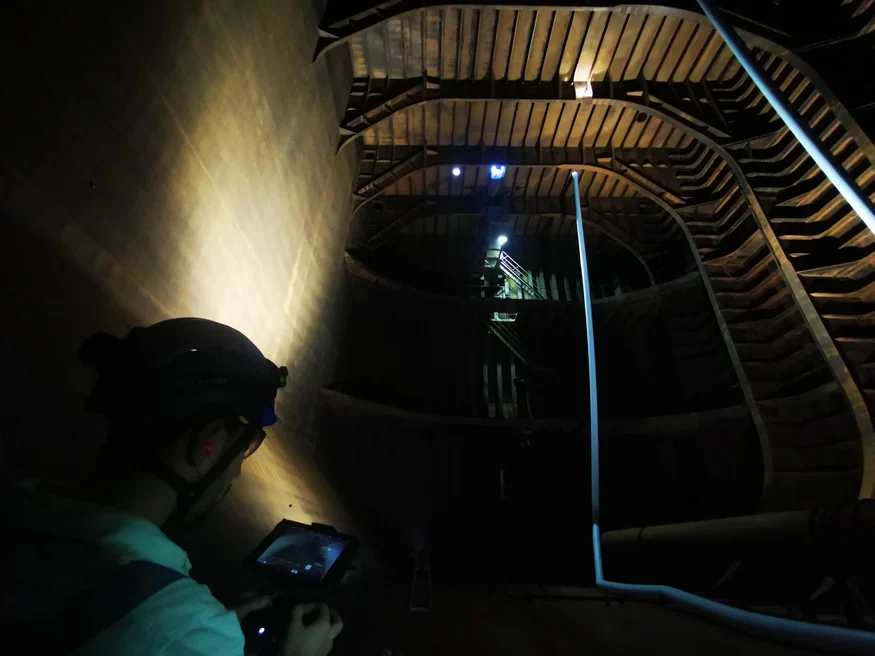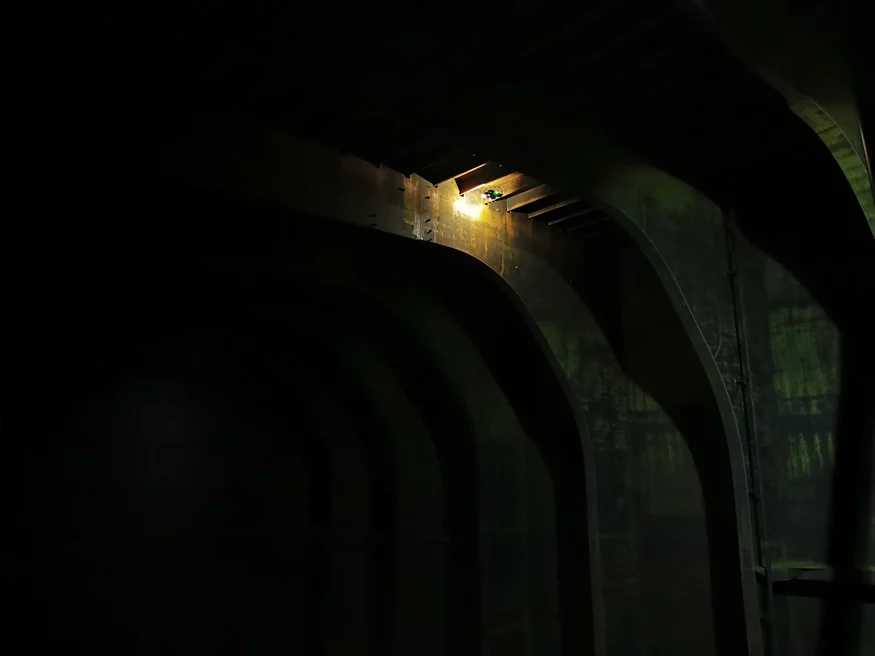C-Bird recently utilized the Elios 3 drone for a hull inspection on a cargo ship. This inspection was conducted more safely, swiftly, and efficiently than ever before, significantly cutting costs and improving operational processes. SAFETY - The Elios 3 inspection eliminated the need for scaffolding in the cargo tanks, preventing approximately 10,000 hours of work at heights in confined spaces. COST REDUCTION - Utilizing the Elios 3 instead of scaffolding for access to hard-to-reach areas resulted in a direct saving of about $1 million during the vessel survey, along with notable reductions in time and logistical expenses. ENVIRONMENTAL IMPACT - Drones replaced traditional methods like rafting, thus avoiding the creation of vast amounts of oil-contaminated water, which would require treatment before disposal. DATA QUALITY ENHANCEMENT - The onboard LiDAR on the Elios 3 enabled precise data localization and facilitated the easy sharing of findings with all stakeholders involved. Over 90% of the world’s cargo-carrying vessels fall under the International Association of Classification Societies (IACS) Common Structural Rules (CSR). The CSR establishes standards for the design, construction, and throughout the lifecycle operations of vessels, with specific criteria based on the vessel classification. Once a vessel enters service, it must renew its Class certification every five years. A major component of a vessel’s Class renewal involves the Hull Survey, which assesses the structural integrity of the ship. Crude oil tankers face some of the most rigorous Hull inspection demands since much of the structure requiring close-up examination is inside the Cargo Oil Tanks (COT), with most critical areas unreachable by surveyors. This makes inspections particularly challenging. To access these unreachable areas, vessel owners typically resort to building scaffolding or filling the tanks with water for a process called rafting. The enormity of a cargo tank is immense—scaffolding work here can reach tens of meters high, making detailed hull inspections extremely challenging. As vessels age, the scope and requirements of hull surveys increase. For vessels undergoing their third or fourth Special Periodic Survey (ages 15 to 20 years), the costs of erecting scaffolding alone can exceed $1 million, representing a significant portion of the overall project cost to achieve Class renewal. Erecting large amounts of scaffolding poses additional safety risks to personnel and operational risks to the vessel. A large workforce is exposed to working at heights in confined spaces. Moreover, foreign objects like scaffold tubes, clips, or tools accidentally left in the tanks can be sucked into cargo pumps, causing damage and leading to unplanned outages once the vessel returns to service. Conversely, rafting presents substantial safety and environmental challenges, including the disposal of vast volumes of oil-contaminated water. A U.S.-based oil tanker fleet operator needed to conduct a No. 4 Special (20-year-old) periodic survey on one of its tankers. The 250-meter-long vessel, classed by The American Bureau of Shipping (ABS), was being dry-docked in Southeast Asia to carry out its Class renewal as well as some other periodic maintenance work. The tanker operator, a robotics innovation leader in the marine industry, had been leveraging C-Bird’s hull inspection services and had witnessed the Class-approved capabilities of the Elios 2 for close-up surveys on their fleet for several years. This partnership had already drastically reduced the need for scaffolding during Class renewal surveys. The goal was to conduct a hull survey for this ship using the Elios 3, minimizing or eliminating personnel entry into the hull to greatly reduce risks while still collecting all necessary data. Initially, there was a plan to use a hull inspection ROV to complete the hull survey. However, C-Bird’s experience with Elios drones made it clear that drones were the better choice in this scenario. Even though C-Bird pilot Malcolm Connolly had previously used an Elios 2 for similar projects, he opted for the newer Elios 3 for this particular ship. He wanted to use the LiDAR live map on the Elios 3 to navigate in environments where he couldn’t see the drone to help guide it. Malcolm was also testing the new UT payload for the Elios 3 to gather ultrasonic thickness measurements. Malcolm of C-Bird guiding the drone around the empty space during the hull inspection The drone was flown into the cargo tanks as part of the hull inspection without anyone entering the space. Malcolm navigated the drone around the entirety of the hull, getting close enough to capture both 4K video footage and a simultaneous 3D LiDAR scan of the structures. The data from the flights was then imported into Inspector 4 for processing. After processing, the comprehensive results eliminated any uncertainties about what the drone had surveyed or the location of any anomalies found—the entire space was recreated in 3D, along with clear video footage. The Elios 3 inspection with LiDAR data alongside the visual feed The Elios 3’s 3D Live Map successfully helped the C-Bird team ensure full coverage of the correct areas without needing to enter the COTs from the safety of the ship’s deck. In addition to eliminating confined space entry, the mission’s safety and efficiency were further enhanced by negating the need to haul equipment in or out of the tanks, thereby reducing the risk of dropped objects and manual handling requirements, including vessel crew support, as well as cutting down the time required to set up for each cargo tank. Malcolm Connolly, CEO and founder of C-Bird, stated, “The 3D laser scan produced by the Elios 3 allows for accurate localization of data. This brings the entire survey process one step closer to true risk-based asset management and eventual automation. The ability to reliably localize data means you can repeat the survey precisely, measure any state of change between surveys, and potentially model rates of degradation with machine learning to predict the optimal maintenance intervention point. This is the direction in which the marine and many other industries are heading!†Malcolm emphasized several key benefits of using the Elios 3 for hull inspections, including: ⦠Full data coverage with the 3D live map ensures surveyors cover all required areas in the tank despite the large size and uniform features. ⦠Safety improvements through reducing human entry into confined and working at height environments. ⦠Cost savings by eliminating the need for scaffolding or prolonged downtime. ⦠Ability to fly in high temperatures—temperatures reached 45 degrees Celsius, and the Elios 3 handled the environment admirably. Thanks to the Elios 3, C-Bird completed a safer, faster, and more efficient hull inspection. By avoiding the need for scaffolding, over 10,000 hours of working at heights were saved. C-Bird and their client both noted the simplified logistics of the overall project and highlighted the environmental impact as this method avoids the need to potentially contaminate water for a rafting-based inspection. They also recognized the drone’s usefulness as an alternative to completing hull inspections with an underwater ROV. The Elios 3 and its 3D map provided inspectors with sufficient data for the Class renewal through accurate data localization, helping them identify points of interest. This contributed to the success of the project as the ship was successfully reclassified. The overall case study presented by C-Bird demonstrates how the continuous advancement of drone technology is enhancing drone capabilities in a way that meets the needs of the marine and maritime industries. Â
Here you can find the related products in Titanium Hdh Powder, we are professional manufacturer of Titanium Hdh Powder,Titanium Hydride Powder, Titanium Grade 5 HDH Wrought Powder,HDH Titanium Powder . We focused on international export product development, production and sales.
Lasting Titanium has been a leading supplier of Titanium Powder since 1990. Our Titanium Powder Annual Export Volume is 600-1000 tons. The annual export volume of titanium powder has accounted for more than 90% of China's titanium powder export volume for 25 years. Lasting Titanium has been a leading supplier of Titanium Powder in a wide range of sizes grades and specifications.
We also supply Titanium Plate , Titanium Sheet , Titanium Plate,Titanium Round Bar, Titanium Rod, Titanium Tube, Titanium Pipe, Titanium Wire , Titanium Fittings, Titanium Drawing and other titanium products. Our titanium products are widely used in aerospace engineering, automotive engineering, chemical and process industries, electrical resistance heating, marine engineering, oil and gas extraction industries, petrochemical processing and so on.
Titanium Hdh Powder,Titanium Hydride Powder, Titanium Grade 5 HDH Wrought Powder,HDH Titanium Powder SHAANXI LASTING TITANIUM INDUSTRY CO., LTD. , https://www.lastingti.comRemote Hull Inspection Saves $1 Million With The Elios 3
Key Benefits at a Glance

Seeking an Alternative Inspection Workflow for Cargo Hull Inspections
Inspecting a Ship’s Hull with the Elios 3 Drone


How the Elios 3 Can Be Used for Hull Inspections in the Maritime Sector?

Streamlining Cargo Vessel Hull Inspections with Drone Surveys
Remote Hull inspection saves $1 million with the Elios 3
# Remote Hull Inspection Saves $1 Million Using the Elios 3
Next Article
Grills for Resorts Enhance Luxury Experience, ROI